Summary

This page lists the caterpillars which are most often mistaken for oak processionary moth (OPM) through our advisory service Tree Alert. All seven of the species described on this page are straightforward to identify, but if after checking this page you are still unsure then please submit an enquiry through Tree Alert.
Please click on the caterpillar of interest to access species-specific information.
Oak processionary moth feeds only on oak and produces large nests on oak trunks and large branches from May onwards. Hairy caterpillars which are not on oak or are not associated with a silk nest are almost certainly not OPM. In very rare circumstances however, caterpillars which have fallen from the nest may be found in isolation, in which case they can be identified as OPM by their long white hairs on a dark, un-patterned body.
All caterpillars with hairs have the potential to be allergenic and direct handling is best avoided. However only oak processionary moth and brown-tail caterpillars produce enough allergens to be considered potentially harmful.
Look-alike species
Some caterpillars feed socially in communal nests built from silk webbing on oak trees which can look similar to those produced by OPM. The two most commonly reported are the lackey moth (Malacosoma neustria) and brown-tail moth (Euproctis chrysorrhoea), which are often encountered during spring and early summer. However, both species will feed on a wide range of other trees in addition to oak.
Small ermine moths (Yponomeuta spp.) also produce large quantities of conspicuous silk webbing on a variety of host trees and shrubs, although they do not occur on oak. They rarely form discrete nests, but instead a diffuse sheeting across the host plant.
Less frequent, are larvae of the small eggar moth (Eriogaster lanestris), which also produces a silk nest. This species was formerly common in hedgerows, but it has become scarce and rather localised. Small eggar moth larvae do not feed on oak.
Although they do not build any form of nest, the hairy larvae of the buff-tip moth (Phalera bucephala), vapourer moth (Orgyia antiqua) and young gypsy moth (Lymantria dispar) are often seen in groups, sometimes in quite large clusters. All three species will feed on oak, but the colourful and brightly marked caterpillars are easy to distinguish from OPM
Quick Facts
This table can be used to identify suspect OPM caterpillars. The important characters for identification are in bold. Sizes represent the usual range for caterpillars when encountered, they may be smaller than this in some situations.
Please click on the caterpillar of interest to access species-specific information
| Name | Hosts and time of year | Nest | Caterpillar |
| Oak processionary moth | Only on oak, caterpillars build nests May-July, but nests may be found year-round. | Small to large rounded nest on the trunk or branch of the host tree. | Dull, grey-brown to black with pale underside. Hairs are extremely long and pale. Small, 20-30 mm. |
Brown-tail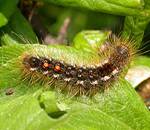 |
Wide variety of broadleaved trees and shrubs, including oak. Caterpillars active March-May, next generation in very late summer-Autumn. |
Nest spun between host twigs in a tent shape. |
Two orange warts toward the tail and white ‘dashed’ markings on sides. Hairs white to orange mid-length. 30-45 mm. |
Buff-tip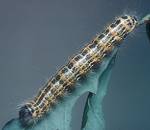 |
Broadleaved trees including oak. July-October. |
No nest built but social when young. |
Dark but with thin yellow stripes and bands, including a V on the head. Short pale hairs. 30-60 mm. |
Lackey moth
 © Steve Bennett ukmoths.org.uk |
Wide variety of broadleaved trees and shrubs, including oak, in April-June. |
Nest spun between host twigs in a tent shape. |
Brightly coloured with blue, orange and white stripes. Short ginger hairs. 40-55 mm. |
Gypsy moth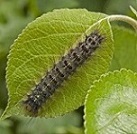 |
Wide variety of broadleaved trees and shrubs, including oak. April-July. |
No nest built, but usually found in groups. 20-50 mm long egg mass may be mistaken for nest. |
Young caterpillars black, but bright blue and orange warts on grey background on mature caterpillar. 10-50 mm. |
Small eggar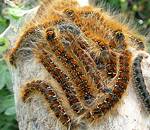 © Jennifer Wiggins ukmoths.org.uk © Jennifer Wiggins ukmoths.org.uk |
Generally hawthorn and blackthorn, rare on other broadleaves. Not found on oak, April-July. |
Nest spun between host twigs in a tent shape. |
Dark with orange-red tufts of hair with white outlines on the body. 30-50 mm. |
Small ermine |
Broadleaved shrubs and small trees, not found on oak. April-June. |
Sheet nest across large areas of the host. |
Pale cream to yellow usually with black spots, but variable. Hairless. 15-20 mm. |
Vapourer © Ian Kimber ukmoths.org.uk © Ian Kimber ukmoths.org.uk |
Wide variety of trees and shrubs, rarely oak. May-September. |
No nest, not social. |
Colourful but variable. Four pale tufts of hair toward the head and two pairs of forward or side-facing black tufts distinctive. 20-40 mm. |
Brown-tail moth (Euproctis chrysorrhoea)
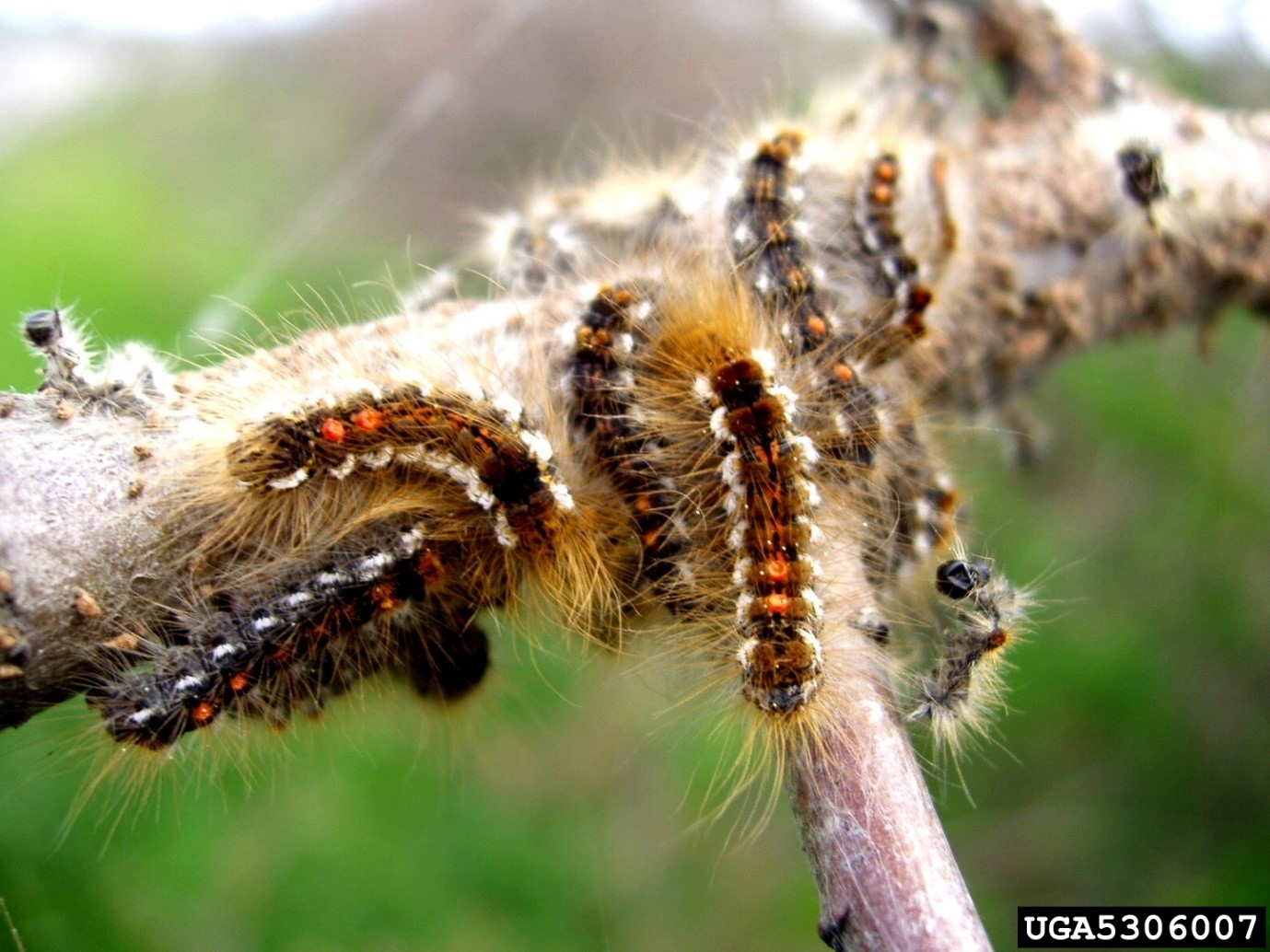
Picture: Brown-tail larvae – Jan Samanek, Phytosanitary Administration, Bugwood.org
The brown-tail moth (Euproctis chrysorrhoea) is found mostly in southern England and Wales, and along some coastal regions further north.
Caterpillars are black and hairy, with white marking down the lateral sides of the body and two distinctive orangey red ‘warts’ towards the tail-end on the back. Approximately 30 mm long.
Nests are spun between host twigs in a tent shape. These nests are more likely to be placed on the outer branches of trees/shrubs compared to OPM caterpillars, whose nests are always on the trunk or large branches of oak trees
Brown-tail adults are active during July and August in the UK and will lay 150-250 eggs that are covered with brown hairs on suitable hosts. Caterpillars take about 3 weeks to hatch, after which they feed and form a dense silk nest during late summer/autumn protecting them over winter. Caterpillars emerge in April and begin feeding, causing significant webbing and defoliation, until they pupate out of sight around late May. This communal living behaviour of the caterpillars, along with their webbing and broadly similar appearance, makes them one of the most common species to be mistaken for OPM.
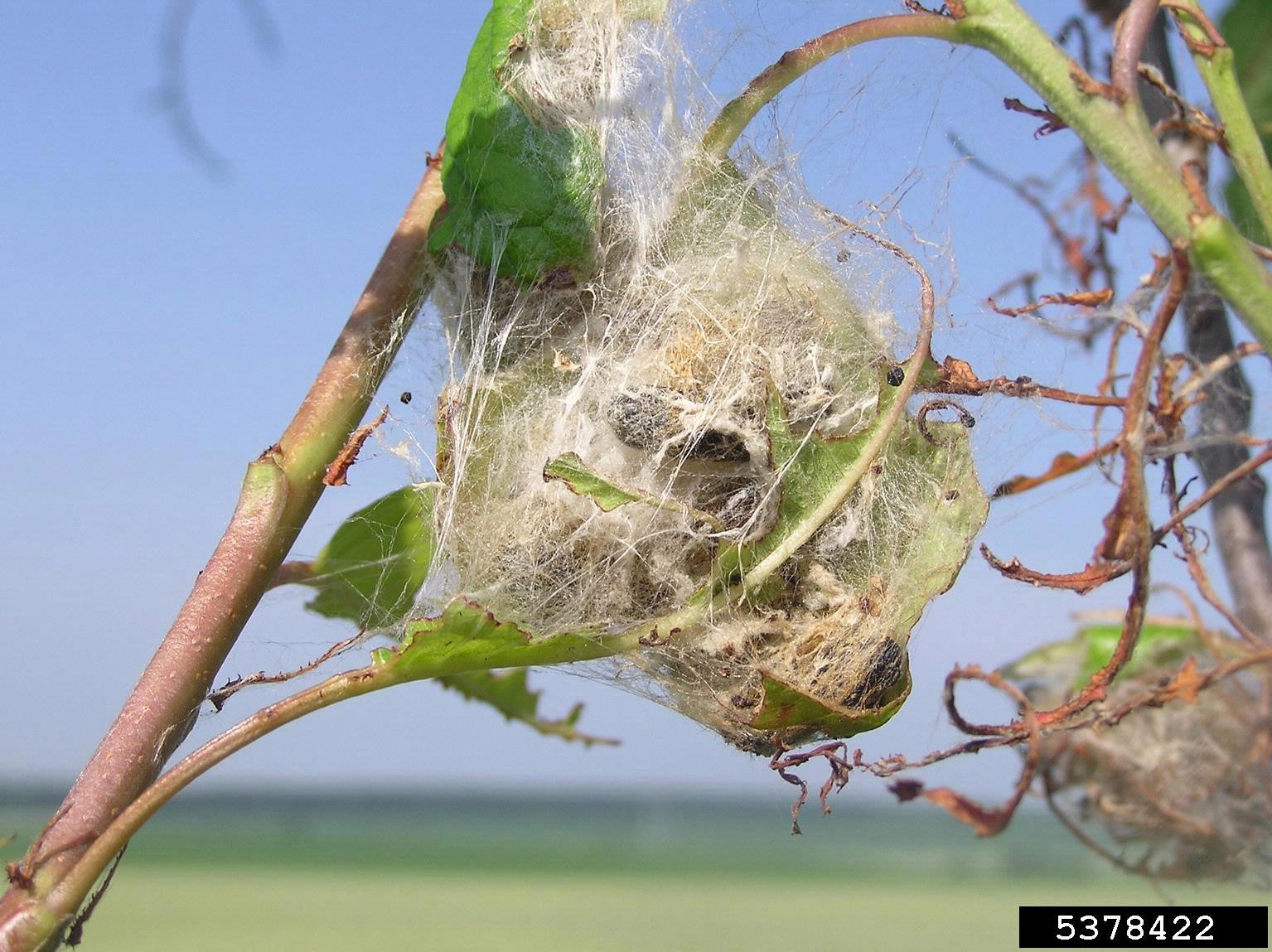
Picture: Brown-tail nest – Milan Zubrik, Forest Research Institute – Slovakia, Bugwood.org
Host species:
Although occasionally found on oaks (Quercus), brown-tail moth larvae are much more common on hedgerow trees such as blackthorn (Prunus) and hawthorn (Crataegus) or on scrubby plants, especially bramble (Rubus).
Impact:
Defoliation caused by the congregating brown-tail caterpillars can look extreme, however plants will tend to recover in the following year.
Although not as severe as OPM, brown-tail hairs can provoke an allergic reaction, in the form of a very itchy skin rash. As such, contact with the larvae or their nests should be avoided. Since the hairs do not spread very far (found locally on the caterpillars, nest and individual host plant), avoidance is usually a sufficient measure against side effects.
There is no statutory requirement to control brown-tail caterpillars, although some councils do have policies regarding the control/ management of them.
Buff-tip moth (Phalera bucephala)
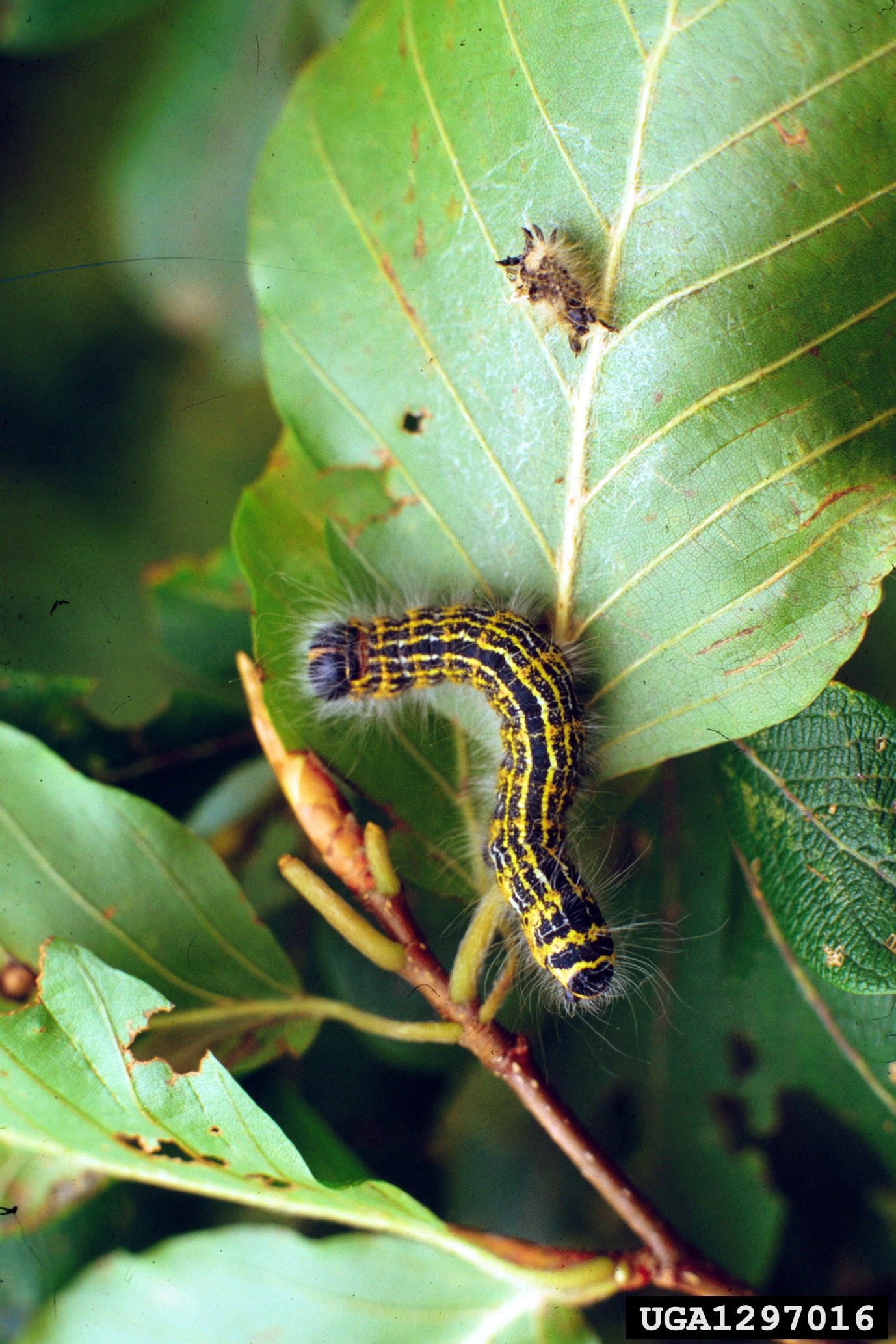
Picture: Buff-tip larvae – Fabio Stergulc, Università di Udine, Bugwood.org
Widely distributed and common, groups of buff-tip larvae can be found feeding on many deciduous tree species, including oak (see below left) and willow (see below right). They are frequently found in woodland, open countryside and urban gardens and parks.
Yellow and black patterned caterpillars with grey/white hairs. Caterpillars can grow up to 50 mm in length and are found in late summer into autumn
Buff-tip caterpillars do not produce nests but do live socially when young,
Buff-tip adult flight season is mainly June-July, and females lay eggs in clusters on the underside of host leaves, with larvae emerging 14-21 days later. Compared with the other OPM look-alike species described on these pages, buff-tip caterpillars emerge quite late in the year, present from around July-October. During this time, they live socially, completing full larval development in approximately 30 days. In October, once fully grown, the larvae separate and enter the soil where they pupate; the adults then emerge from around late May-July the following year and are nocturnal.
Although buff-tip occur later in the summer than OPM, from a distance they can resemble this species when their abundant fine grey hairs (setae) catch the light. However, on closer inspection they are easily identified by their distinctly patterned yellow and black body with grey and yellow stripes.
Host species:
Buff tips are most frequently found on oak (Quercus), willow (Salix), birch (Betula) and hazel (Corylus). They can also be seen on rowan (Sorbus), beech (Fagus), alder (Alnus), hornbeam (Carpinus), limes (Tilia), elms (Ulmus) and sycamore (Acer).
Impact:
As with most species of social caterpillars, defoliation can be severe on small tress. However, as the caterpillars are active late in the summer, there are little to none long-term impacts on the health of the host plants. It is also unusual for an individual plant to be affected by the caterpillars two years in a row. As such, control is rarely, if ever, needed.
Hairs can be an irritant, but susceptibly is variable between individuals.
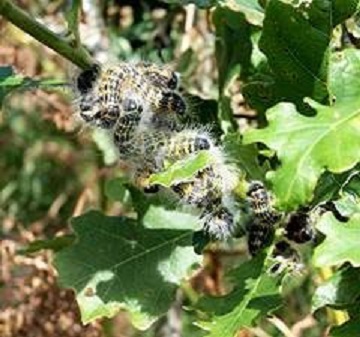
Buff-tip larvae on oak

Buff-tip larvae on willow
Lackey moth (Malacosoma neustria)
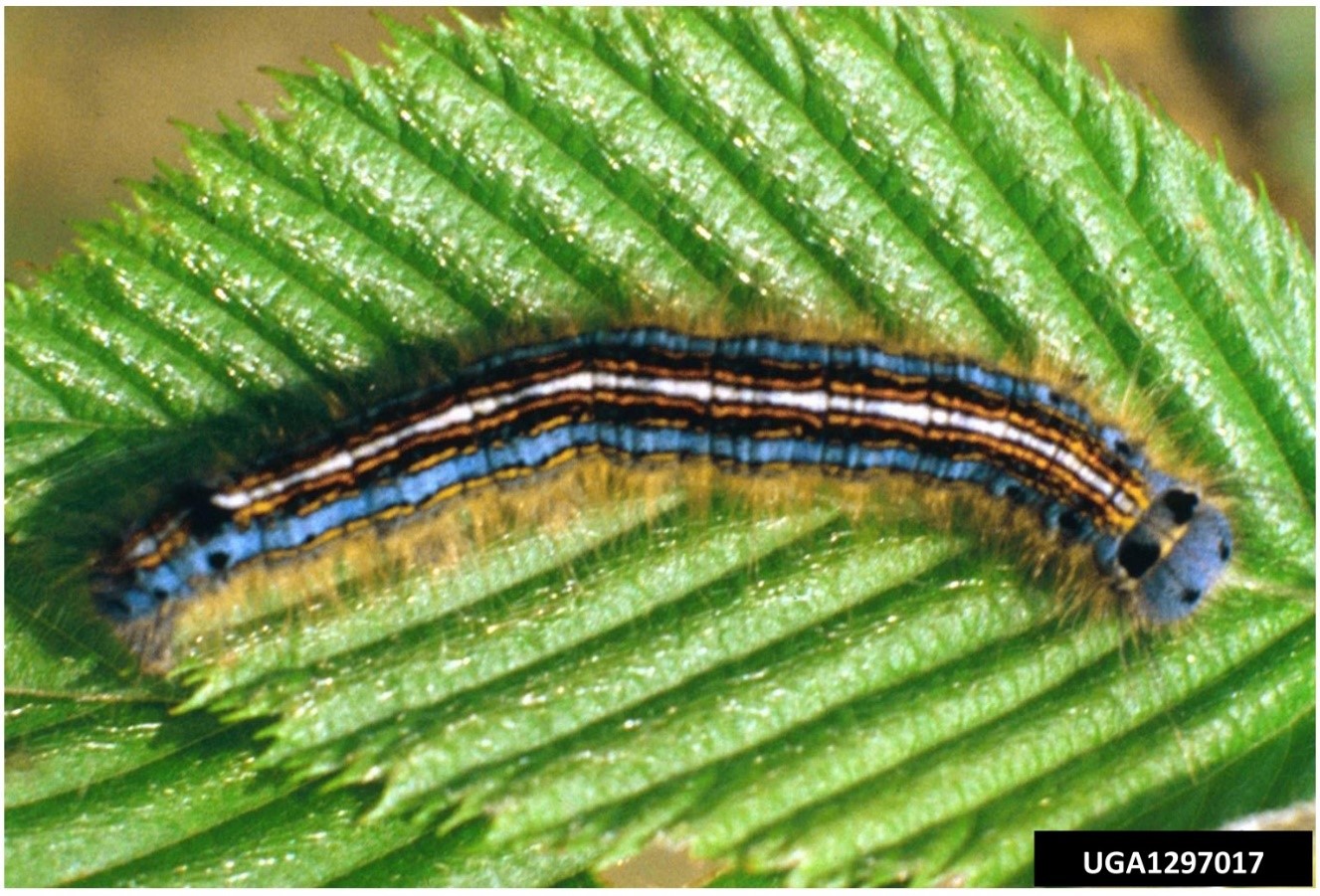 Picture: Lackey moth – LaFabio Stergulc, Università di Udine, Bugwood.org;
Picture: Lackey moth – LaFabio Stergulc, Università di Udine, Bugwood.org;
The Lackey moth (Malacosoma neustria) is found throughout the UK and is common in the southern half of England, along the south and west coasts of Wales, Ireland and the Channel Islands. They inhabit open and wooded countryside on various deciduous trees.
Caterpillars are very brightly coloured with orange, white and blue stripes and are larger than OPM caterpillars, around 40-55 mm when fully grown.
Lackey moth caterpillar nests are spun between host twigs in a tent shape, in comparison to OPM, which has a rounded nest on the main branches and trunk of oak trees.
Lackey moths complete a single generation per year in the UK. Adults are active around late June-August, where they will mate and lay 100-250 eggs in ‘bands’ that encircle small branches of a wide range of deciduous trees and shrubs. The eggs will then overwinter, before hatching into caterpillars in early April the following year.
The caterpillars live gregariously and form silken webs, this behaviour often causes lackey caterpillars to be confused for OPM larvae. Once fully grown (around early June), caterpillars become solitary and disperse to pupate in leaf litter.
Host species:
Lackey moth caterpillars feed on a wide variety of plants including, but not limited to; fruit trees such as apple (Malus), pear (Pyrus), plum (Prunus), and wild and ornamental trees and shrubs, including oak (Quercus), rose (Rosa), elm (Ulmus), birch (Betula) and willow (Salix).
Lackey caterpillars share oak as a host with OPM.
Impact:
Defoliation from lackey caterpillars is more severe on small trees compared to larger specimens, however it should not affect the long-term health and vigour of hosts.
Lackey moth hairs do not cause severe adverse side effects to human health, unlike OPM hairs. However as with all hairy caterpillars, the hairs are potential allergens, though symptoms vary depending on an individual’s susceptibility. Touching caterpillars with long hairs is generally best avoided.
There is no need to manage or control the species.
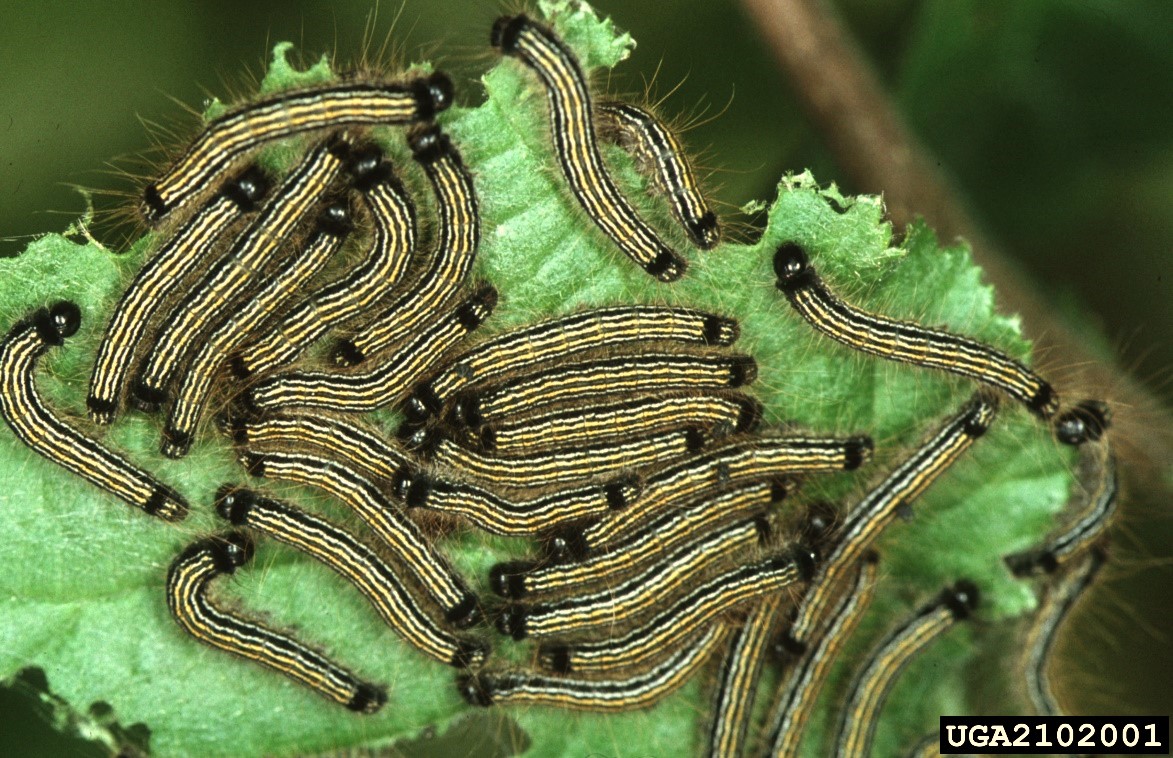
Picture: Lackey moth caterpillar colouration can look lighter when viewed from above in groups – Louis-Michel Nageleisen, Département de la Santé des Forêts, Bugwood.org
Small Eggar moth (Eriogaster lanestris)
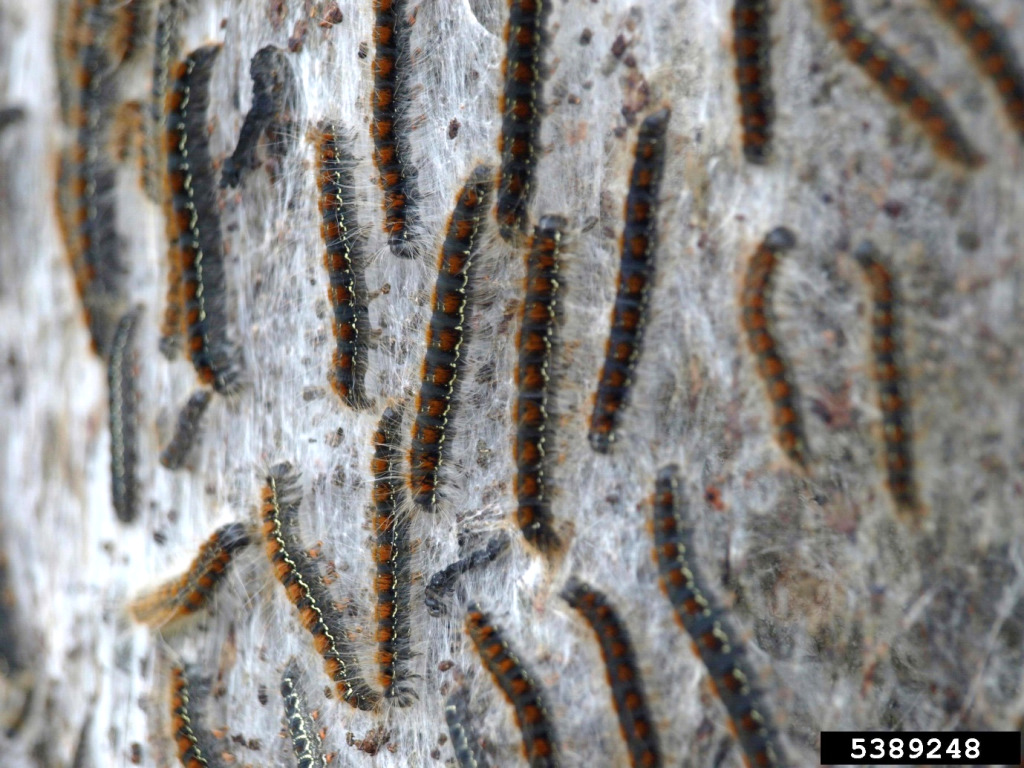
Picture: Mature small eggar larvae – Jan Samanek, Phytosanitary Administration, Bugwood.org
The small eggar moth (Eriogaster lanestris) is a very local species which occurs in widely scattered colonies across England as far north as Yorkshire, in Ireland and in a very few locations in Wales. They used to be much more widely distributed, but have experienced some decline with the destruction of its preferred hedgerow habitat.
In the early stages of larval development, the caterpillars are small and black (see below). As they mature, caterpillars become velvety-black with red-brown marks that are bordered with white, and are completely covered with fine brown hairs, some quite long. The larvae can grow to approximately 50 mm.
Small eggar moth caterpillar nests are spun between host twigs in a tent shape, in comparison to OPM which nests on the main branches and trunk of oak trees in a rounded shape.
Females lay masses of around 300 eggs on twigs and small branches of the larval host plant, these hatch within a few days, between April and May. Shortly after emergence, the caterpillars form silken nests and live gregariously throughout larval development. This takes 6-7 weeks before the caterpillars disperse, pupating in dense vegetation around early July, where they overwinter, before emerging as adults the following year between March and early April. The adults do not feed and only live as this stage for approximately a week, during which adults mate, and females lay eggs.
The communal larval nests and the long hairs of small eggar caterpillars can be confused with OPM. However, small eggar caterpillars emerge earlier in the year, build tent nests between twigs or branches, and do not live on oak.
Host species:
The larvae are found on blackthorn (Prunus) or hawthorn (Crataegus) between May and July. Not found on oak.
Impact / symptoms:
Small eggar moths have long hairs which can cause a rash. However, unlike OPM and some other species, these hairs are not shed onto the host plant, one would need to come into direct contact with the caterpillars to get symptoms. The rash is usually mild, but as with most allergens, symptoms will be variable depending on an individual’s susceptibility.
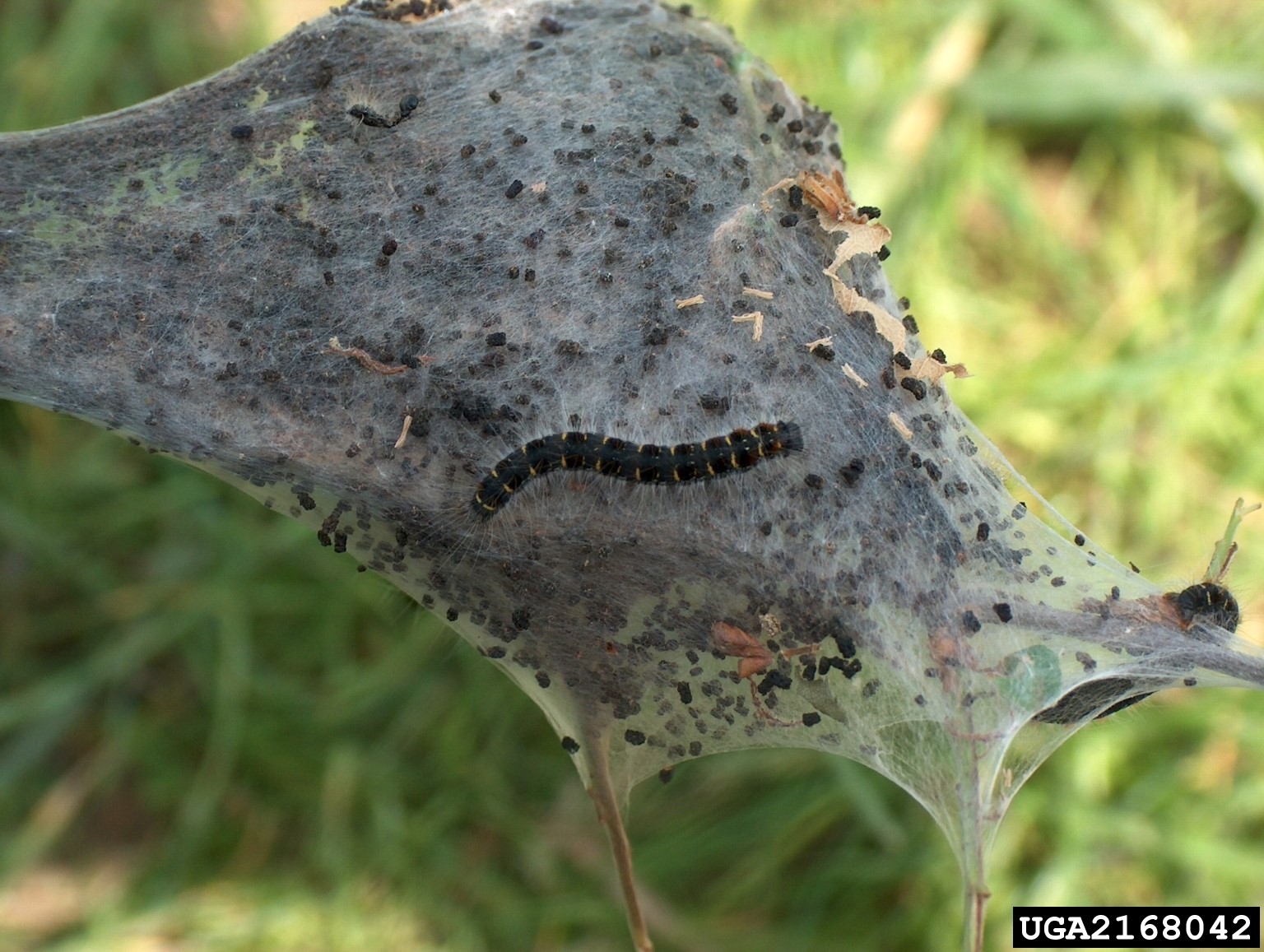
Picture: Immature small eggar larvae – Haruta Ovidiu, University of Oradea, Bugwood.org
Small ermine moths (Yponomeuta species)
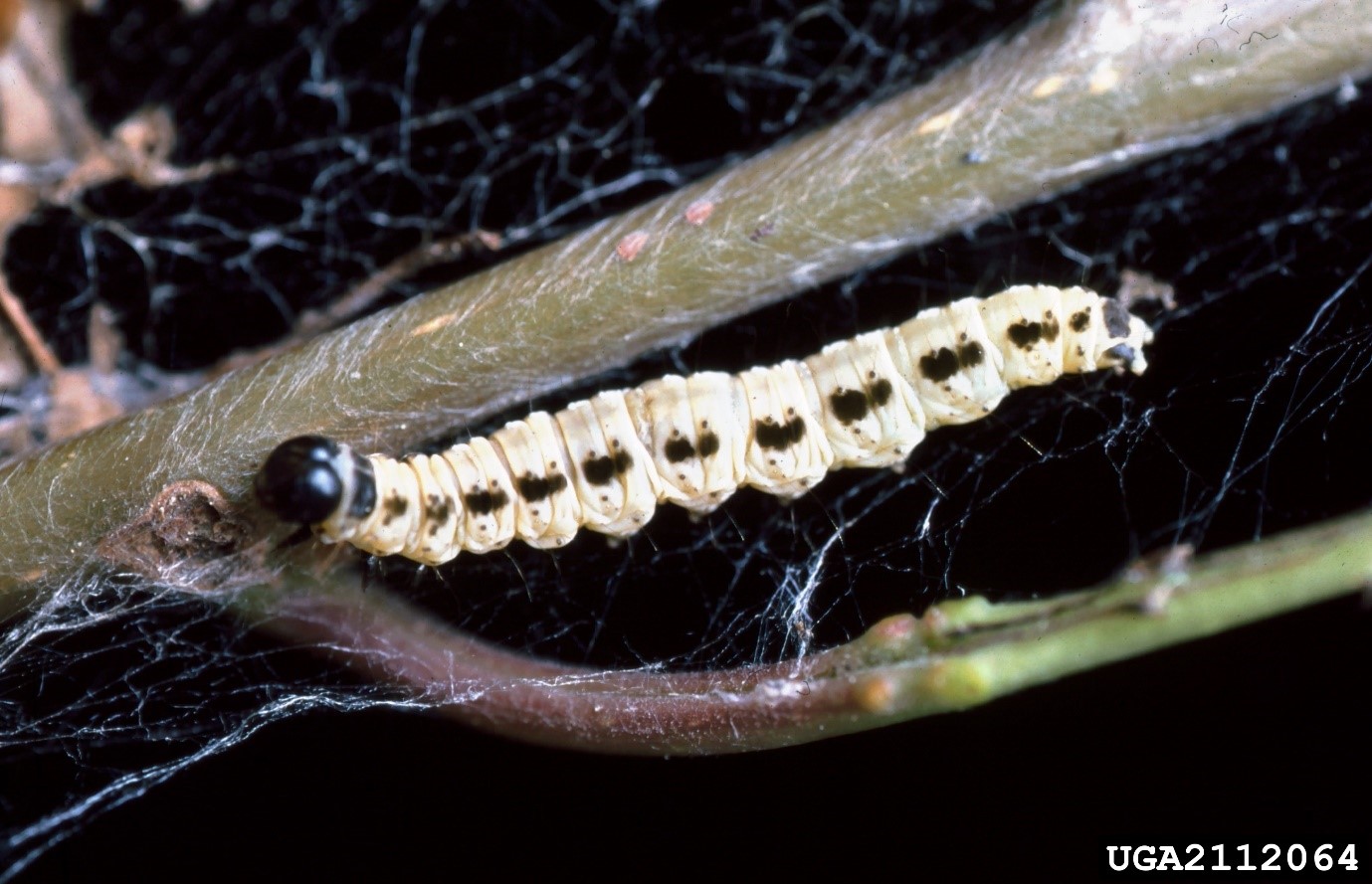
Picture: bird cherry ermine moth caterpillar – Petr Kapitola, Central Institute for Supervising and Testing in Agriculture, Bugwood.org
Small ermine moths are a group of several species widely distributed across the UK. A few widespread species in the UK include: the common small ermine (Yponomeuta padella), bird cherry small ermine (Y. evonymella) and willow small ermine (Y. rorrella).
Caterpillars are hairless, cream/white in colour with variable black markings down the body and can grow to 20 mm in length.
The nests differ from OPM as they do not make one discrete nest, but rather webbing that trails over the whole plant (see below).
Each species of small ermine has a slightly different lifecycle. Most small ermine moth adults are active during July and August, mating and laying eggs. By around late August, larvae will have hatched and overwinter as caterpillars. In spring, the immature caterpillars will begin feeding and are fully grown around June, at this point, they will form silk webbing in which they will pupate into adults. The formation of extensive trailing webs can look similar to OPM nests, and cause misidentification, however small ermine larvae are not known to feed on oak.
The sedum small ermine (Y. sedella) can have 2 generations per year, the caterpillars being active June-July and September-October.
Hosts:
Different species of small ermine moths can be found on willow (Salix), hawthorn (Crataegus), cherry & blackthorn (Prunus), and some other fruit and ornamental trees. Never recorded on oak.
Impact:
The conspicuous trailing silk webs produced in spring and early summer, along with partial-complete defoliation, can cause alarm. However, even in extreme cases it should not affect the long-term health and vigour of the plants. Infestation rarely occurs on the same individual host plants year on year, which gives hosts time to recover.
As these caterpillars do not adversely affect plant, animal or human long-term health, there is no need to control small ermine moths. The caterpillars are an important part of natural biodiversity and help support populations of a diverse range of predators including insectivorous birds.
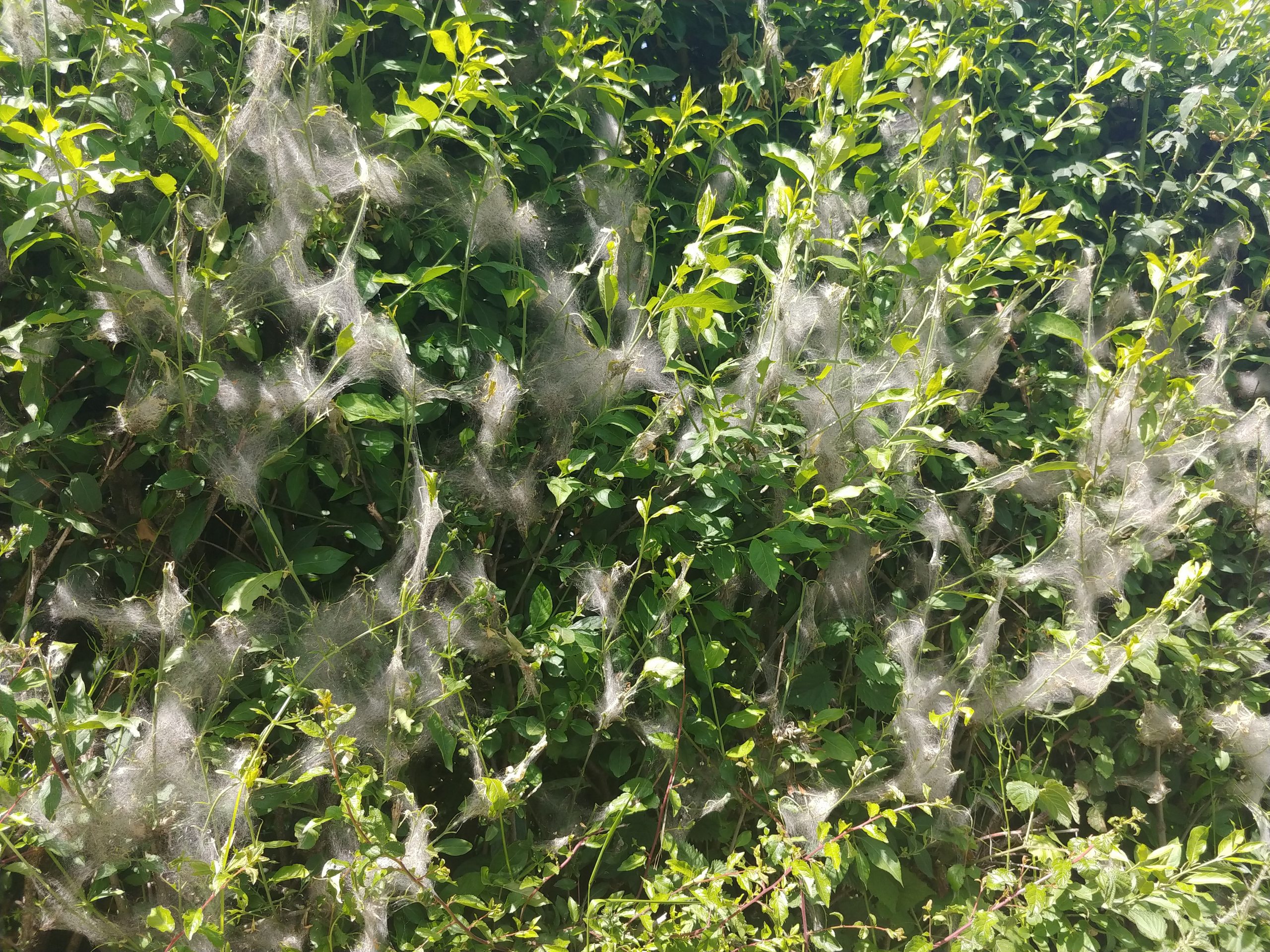
Picture: Small ermine nests
Vapourer moth (Orgyia antiqua)

Picture: Vapourer larvae – Evgeny Akulov, Russian Research Institute of Plant Quarantine, Bugwood.org
Vapourer moths (Orgyia antiqua) are widespread and common throughout the UK, especially in parks and gardens. Larvae may be found at any time between May-August on almost any deciduous tree or shrub.
Caterpillars have a blueish grey body with red spots, a row of 4 tufts of pale-yellow bristles along their back and several single brown or black tufts.
Vapourer moth caterpillars do not produce nests and are not social, compared with OPM caterpillars, which nest on the main branches and trunk of oak trees in a rounded shape.
Adults are active between July-October and usually complete a single generation per year. Since females are wingless and unable to fly, they release sex pheromones to attract males. After mating, females will lay the eggs on the surface of the pupal cocoon, where the eggs will overwinter and hatch the following spring around May.
Despite being conspicuously hairy and frequent on oak, vapourer moth larvae do not produce silk webbing or a nest.
Host species:
Host plants include deciduous trees and shrubs including but not limited to: oak (Quercus), birch (Betula), blackthorn (Prunus), hawthorn (Crataegus), elm (Ulmus), hazel (Corylus), lime (Tilia) and willow (Salix). When conifers are in close proximity to high numbers of vapourer larvae, they have also been eaten.
Impact:
Vapourer moths do not have a massive impact on their host plants, only a slight defoliation, which does not have any long-term negative affects on the plants. The long hairs of vapourer caterpillars can cause mild irritation. However as with most hairy caterpillars, susceptibility to allergens varies depending on the individual, so it is best to avoid touching them just in case.
As the impact of vapourer moths on hosts and to humans/livestock is minimal, control is rarely needed, and caterpillars can be left alone to complete their lifecycle.
